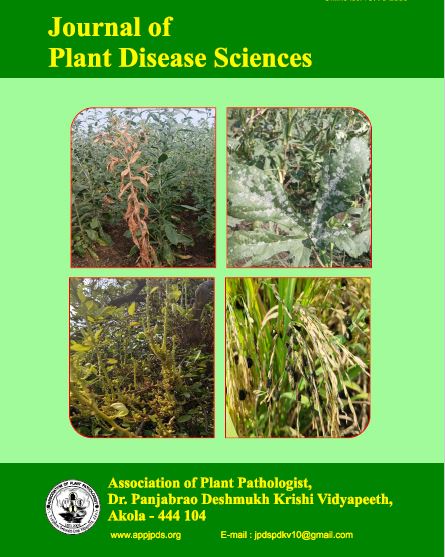ISOLATION AND IDENTIFICATION OF PLANT GROWTH PROMOTING RHIZOBACTERIA ISOLATES IN THE MARATHWADA REGION OF MAHARASHTRA
DOI:
https://doi.org/10.48165/jpds.2025.20.01.07Keywords:
Chickpea, Rhizosphere, PGPR, MarathawadaAbstract
Chickpea is one of the most important pulse crops, contributing a lion’s share to the world’s gram production. Fusarium wilt is a serious soil-borne disease that affects chickpea productivity. Biological control using native Plant Growth Promoting Rhizobacteria (PGPR) isolated from rhizosphere soils offers a sustainable and eco-friendly solution for managing this disease. These PGPR also enhance plant growth by increasing nutrient uptake, siderophore production, and the synthesis and release of growth-promoting hormones.The present study was conducted to isolate and identify potential native PGPR species from the Marathwada region of Maharashtra for the dual purpose of managing Fusarium wilt and promoting chickpea growth. A total of 19 rhizosphere soil samples were collected from healthy chickpea fields across three agro-climatic zones of the region.Among the isolates, species coded as CPP produced medium-sized, white, convex, smooth, regular colonies with yellowish-green pigmentation, gram-negative reaction, rod-shaped cells, and negative sporulation. In contrast, species coded as CSN, CSB, and CSO formed small-sized, white, convex, smooth colonies with irregular to regular margins, light green pigmentation, gram-negative reaction, rod-shaped cells, and negative sporulation.
References
Abdallah, A.B.R., Mokni-Tlili, S.A.H., Nefzi, Jabnoun-Khiareddine, & Daami Remadi, M. (2016). Biocontrol of wilt and growth promotion of tomato plants using endophytic bacteria isolated from Nicotiana glauca organs. Biological Control, 9: 80–88.
Abed, H., Rouag, N.D.A., & Rouabhi, M. (2016). Screening for antagonistic rhizobacteria strains for the biocontrol of wilt of chickpea. Eurasian Journal of Soil Science, 5(3): 182–191.
Anonymous. (2019). U.S. Department of Agriculture. Agricultural Research Service. Food Data Central. Retrieved from https://fdc.nal.usda.gov, accessed on July 20, 2022.
Anonymous. (2019). FAOSTAT – Food and Agriculture Data. Retrieved from https://www.fao.org/faostat, accessed on June 5, 2022.
Anonymous. (2020). Annual Report of Research Work on Pulses, Agricultural Research Station, Badnapur, 2019–2020.
Anonymous. (2021). Agricultural Market Intelligence Centre (AMIC) Report, ANGRAU, Lam. Retrieved from https://www.agricoop.nic.in, accessed on July 20, 2022.
Brigido, C., Singh, S.E.M.J., Menendez, B.R.M.D.R.S.M., Tavares, J.M., et al. (2019). Diversity and functionality of culturable endophytic bacterial communities in chickpea plants. Plants, 14(8). PMID: 30769814.
Chhabra, D., & Sharma, N.A.P. (2019). Non-rhizobial bacteria from chickpea (Cicer arietinum L.) tissues and their antagonistic traits. Journal of Applied and Natural Science, 11(2): 346–351.
David, V., Chandrasehar, G.P.N., & Selvam, R. (2018). A plant growth-promoting rhizobacterium (PGPR) with potential role in biocontrol of crop pests. In Crop Improvement through Microbial Biotechnology.
Glick, B.R., Felix, L.C., Oliveira, R.P., & Carvalho, M.E.S. (2021). Review of Pseudomonas fluorescens isolates for plant growth and disease control.
Jahanshir, A.A., Zahra, A., & Morahem, M. (2016). Evaluation of Streptomyces spp. against Fusarium oxysporum f.sp. ciceris for the management of chickpea wilt. JPPR, 56(3): 257–264.
Jaisani, P.P., & Gohel, N.M. (2021). Morphological and molecular characterization of fluorescent Pseudomonas isolates from chickpea and mungbean rhizosphere soil of Gujarat. International Journal of Agricultural Sciences and Veterinary Medicine, 11(3): 1487–1495.
Kapali, S., Gade, R.M., Shitole, A.V., More, S., Yogeshwar, & Aswathi, S. (2016). Isolation, identification, and utilization of beneficial microorganisms for plant growth promotion and management of chickpea wilt complex. Frontiers in Plant Science, Article ID: 136-4807.
Khanna, A., Kushal, R.P.L., Kumar, V.P.S., & Wati, G. (2022). Antagonistic and growth-promoting potential of multifarious bacterial endophytes against Fusarium wilt of chickpea. Egyptian Journal of Biological Pest Control, 32: 17.
Li, D., Rothballer, M., Schmid, M., Esperschutz, J., & Hartmann, A. (2011). Acidovorax radicis sp. nov., a wheat root colonizing bacterium. International Journal of Systematic and Evolutionary Microbiology, 61: 2589–2594.
Manjunatha, H., Naik, M.K., & Rangeshwaran, R. (2017). Identification of fluorescent Pseudomonas isolates with biocontrol activity from the rhizosphere of crops. Journal of Pure and Applied Microbiology.
Muehlbauer, F.J., Redden, R.J., Nassib, A.M., Robertson, L.D., & Smithson, J.B. (1988). Population improvement in pulse crops: An assessment of methods and techniques. In R.J. Summerfield (Ed.), Kluwer Academic Publishers, Dordrecht, The Netherlands.
Sharma, P., Pandey, R., & Chauhan, N.S. (2024). Biofertilizer and biocontrol properties of Stenotrophomonas maltophilia BCM emphasize its potential application for sustainable agriculture. Frontiers in Plant Science, Article ID: 136-4807.
Singh, A. (2022). Chickpea wilt: status, diagnostics and management. Indian Phytopathology, 72: 619–627.
Soesanto, L., Mugiastuti, E.R.F., & Rahayuniati, R. (2013). Morphological and physiological features of Pseudomonas fluorescens P60. Jenderal Soedirman University, Purwokerto – International Quarterly Journal of Environmental Sciences, 9: 627–632.
Subramaniam, G., Srinivas, V.P.S., Bandikinda, A., Arumugam, R., & Vijayabharathi, R. (2015). Plant growth-promoting traits of Pseudomonas geniculata isolated from chickpea nodules. Biocatalysis and Agricultural Biotechnology, 5: 653–661.
Sunkad, G., Deepa, H.T., Shruthi, R., & Dinesh, S. (2020). In vitro efficacy of PGPR Pseudomonas fluorescens against Fusarium oxysporum f.sp. lycopersici causing wilt of tomato. Plant Archives, 2(1): 430–436.
Vignesh, K., Rajamohan, R., Balabaskar, P., & Liaqat, F. (2021). Identification and characterization of endophytic bacteria isolated from in vitro cultures of peach and pear rootstocks. Biotechnology, 6(2): 120.

